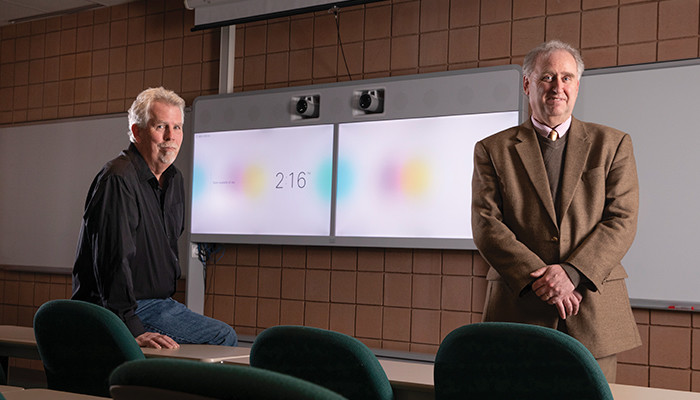Telepresence Boosts Enrollment Rates and Telehealth
ACC was already using telepresence technology to deliver instruction to K–12 classrooms around the region. Then, last July, the college received a $500,000 grant to increase the number of telepresence units and the scope of its videoconferencing work. Previously, ACC had Cisco MX700 telepresence systems at two sites, with 11 rural schools connecting to the institution via the Cisco TelePresence SX10 Quick Set. The grant money will pay for an upgrade to the Cisco Webex Room Kit sets in those schools, as well as equipment for additional K–12 schools and several rural healthcare clinics. The Room Kit features a camera and codec in a single device that works with users’ screens, integrated speakers and microphones, and a Touch 10 controller.
Mark Grunder, ACC’s IT director, points to the tools’ user-friendly nature in explaining why they’re a good fit for offsite users, most of whom lack an IT background.
“The systems are simple to use,” he says. “They’ve been pretty much plug and go. The instructor will walk around the room, and the camera will follow them automatically.”
MacMaster notes that connecting to the region’s K–12 schools is helping to drive enrollment at ACC, which saw a 4.5 percent enrollment bump in the fall of 2019 — the highest increase of any community college in the state.
After rolling out telepresence equipment to healthcare providers, ACC plans to host experts on substance abuse treatment, who will be able to provide training and information to physicians throughout the region all at once. The technology can also be used for patient counseling, treatment or drug abuse education for high school students.
“The technology is flexible enough to be used in multiple ways,” MacMaster says. “We’re going to deploy it and support it, and the experts are going to tell us how to use it for people in need.”
The University of Missouri is also leveraging connectivity to deliver telehealth to far-flung parts of its home state through the University of Missouri School of Medicine and the Thompson Center for Autism and Neurodevelopmental Disorders. The state-funded Project ECHO (Extension for Community Healthcare Outcomes) system relies on Zoom videoconferencing software, along with a variety of hardware, to help train physicians on how to diagnose and treat autism. Rachel Mutrux, senior program director of telehealth at the MU School of Medicine’s Missouri Telehealth Network, notes that the waitlist for new appointments at the state’s six autism centers can stretch up to a year — and without an official diagnosis, patients often can’t receive services. By engaging in training through telehealth solutions, providers across the state can help fill this gap.
“The system increases access for patients, but more important, it increases capacity,” Mutrux says. “A doctor in an autism center can still only see so many patients in a day, even on video, but we’re training 20 providers to all manage their patients. It’s an exponential increase in the number of patients that can be cared for.”
Connectivity and Tech Support Startup Ecosystem
At Portland State University, community partnerships are intrinsic to the institutional mission. “This goes to the very DNA of Portland State,” says Angela Jackson, executive director for entrepreneurial and industry engagement at the school. “Our motto is ‘Let knowledge serve the city,’ and we have a strong history of collaboration with businesses and nonprofits. As with many urban institutions, we not only help provide the local workforce, but we’re a steady source of fresh problem-solving approaches, students to work on those problems and big ideas.”
One such initiative is the Portland State Business Accelerator, which supports tech, bioscience and green companies from early stages through growth. The PSBA offers facilities, programming and mentors, while also helping startups form relationships with university stakeholders and each other.
On the technical side, the accelerator provides high-speed wireless connectivity in common areas and conference rooms, powered by Cisco Catalyst 9300 switches and Cisco 2800 access points. It also connects startups to tech infrastructure resources, including AWS packages, free payment processing and other services.
“The most important thing for growing startups is the absence of friction in their daily operations,” Jackson notes.
After an institution participates in one or two partnerships, the focus on community engagement often takes on a life of its own, says MacMaster, the ACC president. “One program often leads to more opportunities that you didn’t see before,” he says. “There is a virtuous momentum that takes over.”












